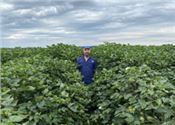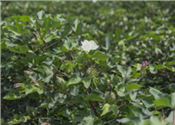Hot Summer Produced A Strong Cotton Crop
BONNIE A. COBLENTZ
STARKVILLE, MISSISSIPPI
Most cotton in Mississippi got off to an excellent start in May, received the heat needed in June and July, and now is ready for sunny skies so growers can harvest a potentially above-average crop.
The U.S. Department of Agriculture estimates 56 percent of the crop is in good or excellent shape, with another 38 percent estimated at fair.
As of Aug. 28, bolls were opening on an estimated 25 percent of the crop.
Brian Pieralisi, cotton specialist with the Mississippi State University Extension Service, said he expects the yield to be above average overall, but the harvest will vary from poor to great in different locations.
“Last year, we harvested 1,116 pounds per acre on average, and there is a chance we match that this year,” Pieralisi said.
A big part of the success of the cotton crop goes back to its start.
Pieralisi said most of the cotton in Mississippi was planted between May 1 and 10. Pockets in northwest Mississippi that were unusually wet were planted the third week of May, and a band across the northern Delta had to be replanted because of a sandblasting event.
“Getting a good start and a uniform stand sets the stage for the yield potential you will have later,” Pieralisi said. “Having a uniform stand and all your cotton planted at the same time helps with management during the growing season. You can do everything at once rather than having one field ready for thrips control or nitrogen application, but other fields are on a different schedule.”
June and July were very hot months, and cotton requires the accumulation of a significant number of heat units to set a good crop.
“Fruit retention was high because of the heat, although we lost some fruit when it got cloudy in August,” Pieralisi said.
About 60 percent of the state’s cotton crop is irrigated. Pieralisi said those growers with the ability to turn on the water as needed should have an excellent crop.
“There were some areas that didn’t have irrigation and didn’t have timely rains, and that cotton is suffering,” he said. “The northern Black Prairie from West Point to Tupelo didn’t get any showers this summer and was the driest region we had. Some of that cotton had a tough time.”
Disease pressure was light this year, with bacterial blight showing up in some places. Target spot is likely to appear because of all the recent rains in late August.
“We’re seeing a lot of late-season potassium deficiency symptoms primarily due to boll fill,” Pieralisi said. “Plants need soil moisture to be able to take up potassium, and the dry soils limited some of the potassium uptake. The cotton relied on relocation from within the plant to attempt to meet the demand of the heavy boll load.”
If cloudy weather clears and the sun shines again and brings a wind to dry out fields, cotton defoliation should begin by the first of September and cotton harvest by as early as Sept. 10.
Will Maples, an MSU Extension agricultural economist, said strong cotton prices remain at the highest levels since 2011, with the December 2022 futures contract peaking in mid-May at $1.32 a pound.
“Macro-level economic concerns and the increase in interest rates by the Federal Reserve fueled uncertainty in the cotton market in early July, and we saw a near 40-cent selloff in the December 2022 futures contract,” Maples said. “Since then, prices have rebounded, and the December 2022 futures contract averaged $1.14 for the week ending Aug. 19.”
Despite high market prices, farmers continue to face higher input costs and inflation that eat into their profit margins.
Unfavorable growing conditions in west Texas are largely responsible for the USDA lowering its estimated of the nation’s cotton production. Those supply concerns are keeping U.S. prices high.
“Ending stocks are currently projected at 1.8 million bales, half of what they were last year,” Maples said. “Even though supply concerns are pushing prices higher, the demand side is limiting how high prices will get. Recession and interest rate hikes will continue to restrain demand.”
So far this year, China, Pakistan and Turkey have been the largest purchasers of the upcoming U.S. cotton crop. ∆
BONNIE A. COBLENTZ: MSU Extension Service

High temperatures in June and July were ideal for cotton, and those with irrigation are in excellent condition. Brian Pieralisi, Mississippi State University Extension cotton specialist, stood in this tall cotton growing Aug. 17, 2022, in Leflore County.
Photo by MSU Extension Service/Will Rutland

The majority of Mississippi’s cotton crop was planted in a two-week window in early May, which allowed for uniform stand development and easier management.
Photo by MSU Extension Service/Kevin Hudson